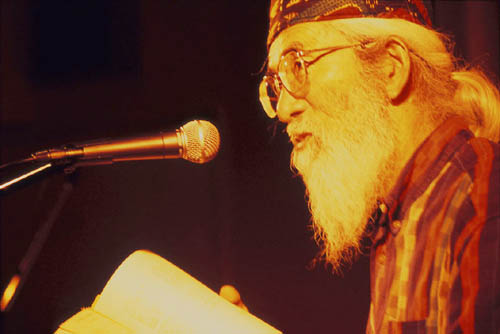We moved down through the valley, beside a stream which led between houses of gorgeous eaves and that rusted benigara hue. At the far end of the village was a grove of three enormous trees, hiding a small shrine that marks the spot where the head of Otsu had been buried centuries before. Once a renowned beauty, she was found to actually be a massive snake and was cut into pieces. Nearby, a group of people were working in a field, the women in long Indian skirts, their children clinging to their backs, or running between the rows, bare blue legs extending from shorts and pumping furiously. We were surprised to run into a few friends, and so after a squat and a chat, we left a bit richer, in hand a bag full of fresh adzuki beans still podded. At the opposite side of the valley, above a another small stream and some old shops, we sat in a park looking across the striated rice fields extending toward striated clouds. Above us were some autumn cherry trees, their few remaining blossoms white and fluffy like the impending flurries the weather seemed to promise. We moved along, past the shops and below a simple pulley system which brought ice cream and other goodies up to people who picnic beneath the cherries on warmer days.
Near the top of the road we turned to enter Sanzen-in. It was pretty quiet today, and we had most of the large tatami rooms to ourselves. A few of the hanging scrolls drew us in, and we'd sit and study them awhile. Moving across squeaky nightingale floors took us further into the temple building, eventually arriving at a small room with a raised dais, colored something like a Tibetan mandala. The wall beside was painted with a single soft stripe, a remarkable control of hues and textures which became a rainbow when the sunlight hit it in a certain way. A friendly monk came up and sat with us awhile, rewarding himself some conversation during a break in the year-end cleaning. We moved out into an area of small forest, between two massive beds of moss, from which small jizo sprouted like mushrooms. The small dark Hondo sat in the middle of the moss, its Buddhist triptych within serenely staring out toward the cedars. One of these giant trees had a trunk like a whale's tail. Another monk sat nearby, nodding off, his head coming precariously close to his desk as he drooped. Not wanting to disturb him, we crept back out in the plush world of moss, moving toward another garden above. In other seasons, this is all all hydrangeas. One can imagine a world of bursting blue, contrasting dramatically with a series of orange bridges over the streams rushing down from Hiei above. Tiny black statues filled the halls and small shelves here, many erected out in the courtyard itself due to the overflow. Due to their size and the way they're displayed, it all looks like the spice rack of the gods.
Moving back down the hill toward the bus stop, stopping for a cup of tea and a look at the sky. The sunlight was contorting itself through the breaks in the clouds, beaming like the halo of the large Amida we'd just left behind. The weather today looked like it would hold. The only swirls we'd see overhead would be the painted maidens gliding gracefully across pale blue ceilings, the notes from their lyres taking shape as the Nembutsu. Merrily we'd dance toward the Pure Land...
On the turntable: Ootaka Shizuru, "Sizzle"
On the nighttable: Fyodor Dostoevsky, "The Idiot"
On the reel table: "Down by Law" (Jarmusch, 1986)


